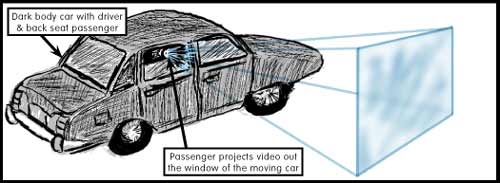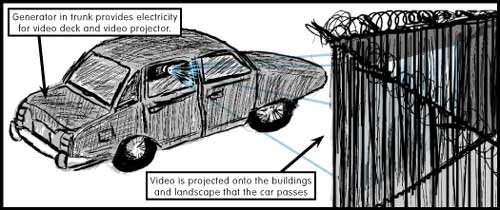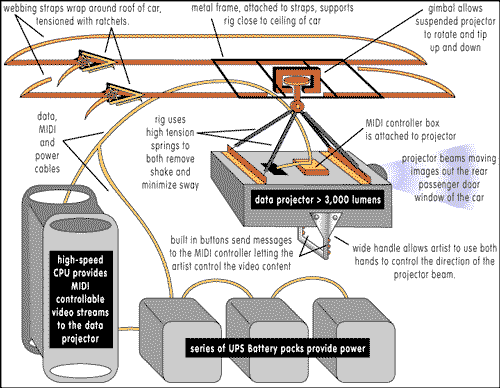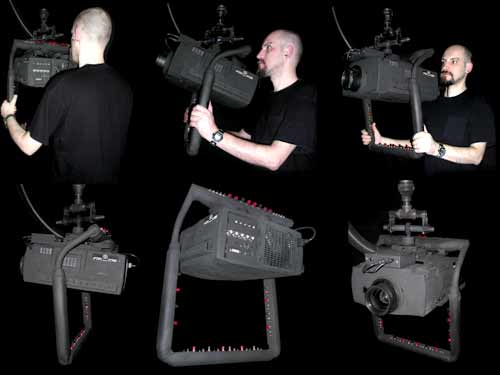|

|
 |
| July
21st - July 24th, 2003 |
click
button to see maps and performance routes |
 |
 |
|
|
| This
proposal is a variation on previous "Drive-By"
performances. Check out "Drive-By"
2001 and "Drive-By"
1999 to see these previous encarnations. |
 |
| The
artist refers to this piece as a ‘video projection
performance and roving installation’. The emphasis
is on the action, the content of the video and the interaction
between the projection and the environment. The audience,
those expecting the show and those who chance upon it, get
to see random moments from the video. The projected video
consists of a live mix of digital video streams from a high-speed
computer being controlled by the artist/projectionist. |
 |
| Drive-By
consists of a number of site-specific installation/performances.
A dark car is driven around each site (streets of New York
City). The artist is in the rear seat equipped with a data
projector connected to a computer. He points the projector
out the window of the car, hitting specific surfaces of
the location with projected digital video. The artist controls,
live, the direction of the projection and the content of
the video. Each site has its own set of video streams for
projection. Each incarnation of the performance will be
documented and combined with the original video streams,
to produce a DVD as the end product of the piece. The work
embodies notions of ephemeral, virtual, non-destructive
graffiti coupled with the guerrilla tactics of a drive-by
shooting, while also addressing formal issues such as surface,
motion and the fleeting moment. |
 |
 |
| Completed
projection unit dubbed "Video Remix Artilery Gun".
It mounts as above from the ceiling of the car, is suspended
from a gimbal so it can resist the inclining of the car
as it moves and can be pointed in any direction. It features
60 midi switches which allows the artist to play any of
60 video clips at any time (just as musicians play midi
instruments, with video relplacing audio). |
| A
low-resolution version of Drive-By has been performed/installed
twice at the D.U.M.B.O. Art under the Bridge Festival. In
that version two of the proposed sites were used: Times
Square, Manhattan and the D.U.M.B.O. area, which is located
under the Manhattan Bridge on the Brooklyn side. A 600 lumen
projector was used, hand held to project somewhat successfully,
if a bit shakily, on the dark D.U.M.B.O. streets and rather
unsuccessfully on the bright streets of Times Square. I
am proposing to remake the piece with high resolution, computer
controlled video streams, for all sites. These video streams
will then be projected from the moving car by a brighter
data projector (3,000 lumens) which will be customized to
hang inside the car with a rig designed for the artist to
control its direction without having to support its weight
(see above). It will be connected to a computer delivering
the video feeds and the artist will control the content
using a custom MIDI controller on the handle of the projector
rig. |
 |
|
The
production of this piece, which culminates in a DVD, starts
with the shooting of the original material which make
up the video streams. Each site serves as the source material
for the projection onto its paired site (e.g. video shot
along the streets of Coney Island are projected on 5th
Avenue, Manhattan, and vice versa). Tripod, steadycam
and roving pan shots of the neighborhoods, documenting
the essential visual elements and concepts descriptive
of the area, form the substance of the shoots. This footage
will then be edited and prepared into video streams for
projection.
Next
the projections are installed/performed at the sites:
a dark body rental car is rigged with the projector set-up,
a computer loaded with the video streams and UPS battery
systems to provide power. The artist and a driver perform
the piece in each location pair on different days while
a camera person documents the events. Footage of the performance/installations
and the various projection footages will be combined in
post-production to create the final dvd.
|
 |
| In
this example, which was part of the 3rd Annual D.U.M.B.O.
Art Under the Bridge Festival, the performance was executed
in two parts. The first consisted of a video sequence depicting
Times Square being projected repeatedly onto a derelict
block in Brooklyn. The block is surrounded by a continuous,
corrugated, galvanized, iron fence, topped with razor wire.
The car made approximately 20 laps of the block. The second
part consisted of depictions of the Brooklyn block projected
onto Times Square. The car made numerous passes through
Times Square, hitting as many surfaces as possible with
the projection. While the Brooklyn location was close to
other events in the festival and was advertised, the Times
Square part was done ‘guerrilla’ style, with no
warning and therefore no expectant audience. |
 |
| This
“Drive-by”, obviously, mimics the modus operandi
of a drive-by shooting: a slow moving, dark car with a rolled
down window creeps along near the sidewalk, ‘shooting’
video images at all that gets in its path. The superficial
images skim the surfaces and textures of the recipient walls
and objects. In the case of the block in Brooklyn, the video
image ripples as it travels along the corrugated fence.
The highly pixilated image glistens against the dull grey,
due both to the nature of the subject matter (Times Square’s
sparkling neon, tv screens etc.) and because the metal fence
reflects the projector light in all directions (the curves
of the corrugation make for a full 180 degrees of surface
to bounce off). |
 |
|
The
surface glamour and glitz of Times Square has been stripped
and reapplied to the Brooklyn fence in a thin, ephemeral
veneer. What once may have impressed the onlooker now
shows itself to be just a cosmetic surface that is powerless
in any attempt to cover up the desolation of the Brooklyn
block.
In Times Square, where all surfaces sparkle and glow with
light, the projection of the Brooklyn block adds another
layer, another surface to an already cluttered environment.
The projection serves to remind us that the images and
surfaces that comprise Times Square are just that, image
and surface. They are only as deep as the materials they
are made of and last only as long as the advertisers pay
for. The Brooklyn images are images of reality that are
momentarily usurping the unreal. Times Square, stripped
of its surface decorations, could easily be a dark and
run down neighborhood; the Brooklyn block projection gives
us a glimpse of the view through the crack in the polished
surface.
Of
course, the artist fails to overwhelm the brightly light
billboards and monster tv screens with his images, mirroring
the inability of any individual to impact huge corporations;
but his images do make it through to the ‘dead’
spots, the holes in the fabric of consumerism and most
importantly, he is not deterred, he has tried despite
the odds and it is the doing that gives life to the piece.
Should the artist amass the financial strength to bring
an enormous daylight bright projector to the location
and completely burn his images onto the brightest billboard,
we know he would; in the meantime he has succeeded in
making a small dent in an enormous cultural icon for the
few that glimpsed his images
|
 |
|
"Drive-By"
is a set of performance/installation events with many
contributing elements. It uses the streets, architecture,
people and images of New York City as both the content
and canvas for an ephemeral portrait of the city, complete
with all its complexities and paradoxes. It takes the
personal cityscape of the artist and expands it into a
descriptive of socio-economic diversity, of architectural
metaphor and neighborhood identity.
After gathering footage from specific paired neighborhoods,
the artist renders video streams that try to summate the
visual 'gestalt' of those areas. Each video stream set
(group of video clips) is made available for live mixing
by means of programmable software and an array of programmable
buttons. The artist, situated in the rear seat of a moving
car, projects these video streams out the rolled down
window onto the landscape of the chosen neighborhood,
changing the content (mixing and choosing video streams)
as he sees fit.
Images from one location are projected onto the landscape
of its pair and vice-versa: these locations are chosen
for their differences and the dichotomies in society that
they represent. The juxtapositioning of incongruent, virtual
landscapes with the real incites one to re-examine both
and to produce associations previously unmade. A poor,
dilapidated neighborhood projected onto a wealthy landscape;
a brightly lit, fantastical location projected onto a
barren, desolate one; a business area superimposed on
a residential... and, of course, the reverse of all the
above.
The artist uses urban guerrilla tactics to present his
work; the car, dark and slightly sinister, moves amongst
the other traffic without revealing its intentions until
the right time where, like a drive-by shooting, it surprises
its recipients (buildings/architecture) with a shower
of digital pixels. In the less traffic-laden streets,
the car delivers its payload in a slow, calculated fashion.
While this piece is performed, both by the process of
projecting from the car and by the live remixing of the
video content, the performer remains somewhat anonymous;
he is the shadow behind the bright light, akin to the
drive-by gunman, implying that we are witnessing something
we shouldn't. The bringing together of two opposing locations,
the usurping of the real by the virtual, the implied commentary,
the unexpectedness and the resultant beauty all have the
feel of an underground, alternate view of the city fighting
to be known. As quick as it appears, so it retreats as
the car disappears around a corner or into traffic.
A number of paired locations are chosen, each of personal
significance to the artist, having worked, lived or socialized
there. An immigrant from Ireland who started out in America
with nothing, working minimum wage jobs and surviving
hand to mouth, the artist fulfilled his American dream
by working his way to the top of the events production
industry, overseeing productions for the wealthiest of
New York society. He has a unique perspective both because
he came from the outside and because he was privy to the
extremes of society which co-exist while never really
interacting. He is taking those extremes and forcing an
interaction, albeit momentary and non-physical. He is
using the mechanisms of a drive-by and graffiti to modulate
and invigorate our reading of the sites chosen. His graffiti
is moving and non-destructive; his drive-by gives illumination
instead of taking life. The fear of the other is brought
about by the severity of contrast, but in this piece the
contrasted also unite.
The architectural landscape of New York City is mostly
made of boxes with facades and often those facades are
layered with adornments and advertisements and perhaps
those with graffiti. Drive-by adds another layer to these
surfaces, a fleeting, moving layer beholden to no monetary
gain, selling no product although, perhaps claiming territory,
like graffiti. These multiple layers form a metaphor for
the strata of society, with the structural obscured by
the trappings of wealth and capitalism which in turn are
usurped by the destructiveness of the disenfranchised.
The artist both participates in and exposes this process
in Drive-By.
|
 |
 |
|

|
|
 |

